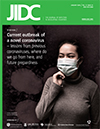Analysis of patterns of antibiotic prescribing in public health facilities in Nepal
DOI:
https://doi.org/10.3855/jidc.11817Keywords:
antibiotic use, antibiotic prescribing, antibiotic resistance, public health facility, NepalAbstract
Introduction: Inappropriate use of antibiotics is recognised as a leading cause of antibiotic resistance. Little is known about antibiotic prescribing practices at public health facilities in low- and middle-income countries. We examined patterns of antibiotic prescribing in public health facilities in Nepal and explored factors influencing these practices.
Methodology: A cross-sectional study of antibiotic prescribing in public health facilities was conducted in the Rupandehi district of Nepal. Six public health facilities were selected based on WHO guidelines, and data were extracted from administrative records for 6,860 patient encounters. Patterns of antibiotic prescribing were investigated using descriptive statistics. Chi-squared tests and logistic regressions were applied to explore factors associated with antibiotic prescribing.
Results: Of patients attending public health facilities, the proportion prescribed at least one antibiotic (44.7%) was approximately twice the WHO recommended value (20.0 to 26.8%). The antibiotic prescribing rate for hospital inpatients (64.6%) was higher than for other facilities, with the prescribing rate also high in primary health care centres (50.4%) and health posts (52.2%). The most frequently (29.9%) prescribed antibiotic classes were third-generation cephalosporins. Females (p = 0.005) and younger (p < 0.001) patients were more likely to be prescribed antibiotics. High prescribing rates of antibiotics for selected diseases appeared contrary to international recommendations.
Conclusion: Antibiotic prescribing in public health facilities was high compared with WHO guidelines, suggesting the need for strategies to reduce misuse of antibiotics. This study provides useful information to assist in formulating policies and guidelines to promote more appropriate use of antibiotics in Nepal.
Downloads
Published
How to Cite
Issue
Section
License
Authors who publish with this journal agree to the following terms:
- Authors retain copyright and grant the journal right of first publication with the work simultaneously licensed under a Creative Commons Attribution License that allows others to share the work with an acknowledgement of the work's authorship and initial publication in this journal.
- Authors are able to enter into separate, additional contractual arrangements for the non-exclusive distribution of the journal's published version of the work (e.g., post it to an institutional repository or publish it in a book), with an acknowledgement of its initial publication in this journal.
- Authors are permitted and encouraged to post their work online (e.g., in institutional repositories or on their website) prior to and during the submission process, as it can lead to productive exchanges, as well as earlier and greater citation of published work (See The Effect of Open Access).








